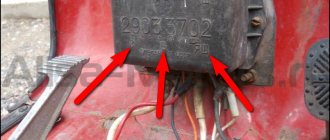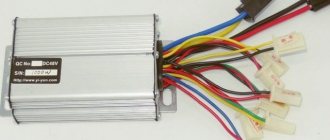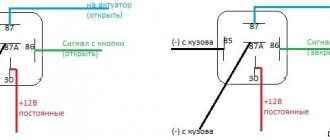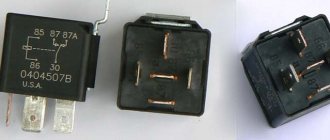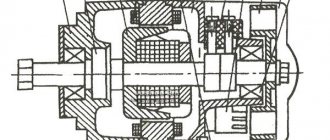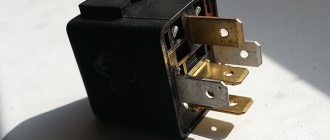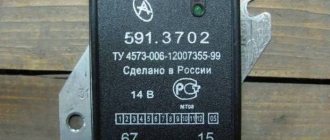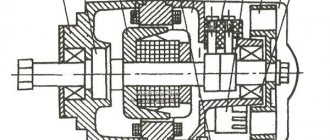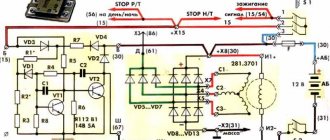- How does a relay regulator work for a bike?
- What to do if the relay regulator is broken
- In what cases can you ride a motorcycle without a regulator relay?
Motorcycle equipment is equipped with a large number of mechanisms that must work efficiently and smoothly every day during the motorcycle season. The operation of all systems and components of motorcycle equipment must be regulated so that sooner or later the motorcycle does not fail and does not turn into a pile of metal. For this, there is a certain mechanism called a relay regulator. They are used to ensure that the voltage for the movement of the motorcycle is supplied to a certain level.
How does a relay regulator work for a bike?
Normally, the voltage supplied to the on-board circuit of any motorcycle device should not exceed twelve volts. However, the generator is capable of producing a higher voltage level. Typically it ranges from eight to forty-five volts. If such voltage is regularly applied, all motorcycle electronics may fail. The motorcycle will turn into a pile of metal. It is to protect against power outages that a motorcycle relay regulator is installed on motorcycle equipment.
Relay regulators are installed on all imported motorcycle vehicles. The role of the regulator relay is colossal. Thanks to it, you can avoid expensive motorcycle repairs. In addition, all systems are guaranteed to work like a well-oiled mechanism and will not fail for a long time due to failures in the voltage supply to the on-board networks of the motorcycle.
Motorcycle Voltage Regulator Relay Diagram
Recently, at a training session on how to control a motorcycle, instead of a lesson, I had a bummer. The Chinese motorcycle Stels Flex 250 acquired an unpleasant habit: after starting, it continued to turn the starter. The coach, the famous Chelyabinsk gymkhana athlete Pasha, changed the stuck starter relay, and everything became fine. For the first two times. And then the damn moped habit came out again. Upset Pasha said that he was changing it for the fourth time in 2 days. Either the starter suddenly became harder to turn (and consumed more current, which led to the relay burning out), or the relays from Alpha were delivered to the store, but Pasha was already getting ready to load the moped onto the trailer and take it to the service center. This is what the original relay from Uncle Liao looks like:
And then the bright thought came to me that the relay is also a relay in Africa (yes, yes), so if the new Chinese relay does not hold, it must be replaced with the old Japanese one. And if it burns out, you can change the starter. There is still nothing to measure the starter current, I couldn’t find a current clamp for a constant voltage, and there are no multimeters with such measurement limits. If you change the starter right now, you can waste money and lose a lot of time. So it’s decided - we’ll go for analysis. During disassembly I came across a relay from Siber (like this):
which, with the help of a soldering iron, was brought into a state compatible with a Chinese motorcycle. I have experimentally established that the contacts closest to the fuse are the control circuit of the relay, and the two farthest ones receive power through the fuse, which, apparently, is the main one in Siber. We don’t need a fuse, so we leave the two far ones alone, and solder wires from a Chinese relay to the two near terminals (so as not to be fooled).
Here I found a photo of such a relay with a connector. I didn't get the connector, I had to solder it.
Blue - positive from the starter button. Green is minus. Two red ones - we don’t use them.
We connect it, check it several times - everything works and nothing burns. The moped rides again and makes the cadets happy. By the way, the Japanese relay could have been inserted into the original Chinese rubber band that holds it on the frame, but I bought it with a Japanese one, and installed it with it, bending the petals.
The moped rides again and makes the cadets happy. By the way, the Japanese relay could have been inserted into the original Chinese rubber band that holds it on the frame, but I bought it with a Japanese one, and installed it with it, bending the petals.
For those who are electrically savvy, you don’t need to read any further. And for those who are wondering whether it is possible to install a relay from one motorcycle to another and whether this will not burn out the starter/instrument/gas tank, I’ll tell you a little about the hardware.
A starter is an electric motor. Its task is to spin the crankshaft of the motorcycle engine and force the generator to produce the energy needed to form a spark, set the piston in motion, and so on. Those. do the same thing that happens when starting with a kickstarter or from a pusher. During operation, the starter consumes very large currents, so it cannot be connected directly through a button; there are no such buttons. In order to control a circuit in which a large current flows, a relay is used. A relay is a controlled switch that is controlled by a low current and allows you to switch (switch) circuits with a high current. When we press the starter button, 12 volts from the on-board network are supplied to the control circuit (coil) of the relay, this coil becomes an electromagnet, magnetizes the contacts inside the relay to each other and thereby closes them together, and they transmit voltage from the battery through thick wires to starter. A very large current flows through this circuit (i.e. and through the contacts inside the relay) during starter operation, which can weld the contacts of a low-quality relay to each other, and therefore it does not turn off after we release the starter button and the control circuit ( electromagnet) is de-energized.
There are absolutely no parameters by which we can determine whether this or that relay is suitable for us. The first is switched current , i.e. at what currents will it work reliably without welding the contacts to each other. The second is the control circuit current . The third is the operating voltage of the switched circuit and control circuit. When we take a relay from the 600th Siberian, we know that it can switch large currents (since the Siberian starter must crank a large and heavy engine). The first parameter is fine. The control circuit of the relay from the motorcycle is powered through the starter button, i.e. It is unlikely to consume very large currents. So even a button from a Chinese steering wheel should not die from installing a Japanese relay. With the second parameter, everything is more or less clear (as a last resort, we’ll replace the starter button with a Japanese one :D) Well, the third parameter - the on-board voltage - is the same on most motorcycles, 12 volts.
So: if the starter relay died on the road, there is nowhere to get the original one (or it can obviously die again) - you can install literally any relay from a large motorcycle. Nothing will burn, melt, etc. The only difference is that the relay from a large motorcycle has a greater safety margin (because it can hold more current). And what current flows through it depends on the starter.
What to do if the relay regulator is broken
Sometimes a situation occurs when the relay regulator becomes faulty. In this case, there is no need to panic. It is very important to take certain measures to prevent all motorcycle systems from failing.
First, you urgently need to disconnect this device from the generator and from the battery so that they do not fail. The voltage will be supplied alternately.
The main thing is to pay attention to ensure that the generator does not fail. In this case, the voltage will be supplied from the battery, where there is a possibility that it will begin to boil away and increase in size. The result will be an explosive situation.
The motorcycle regulator relay diagram shows its structure. Thanks to this, you can figure out how to repair it and connect it.
How to check PP with a multimeter on a moped?
The relay regulator on a Chinese scooter is checked using a multimeter with a voltmeter function. For this purpose, a simple DT-830 (or equivalent) is usually used. It is better to carry out diagnostics and measurement of output voltage with the device removed.
Verification algorithm:
- You need to unscrew the fairing with the central phase and find on the frame a device with 4 wires: red, green, yellow and white.
- Then start the scooter and check the voltage at idle: measure it between the green and red wires, setting the multimeter to the maximum value of 20 V.
- If the multimeter display shows a figure of 14.6-14.8 V, this is normal. For stabilizers on Chinese mopeds, this is the operating standard voltage. If at idle the multimeter shows a value of 15-16 V, this is a high voltage indicator. This indicates a malfunction of the relay regulator.
- Then you need to check the voltage supplied to the lighting lamps. An alternating voltage is supplied to the central low beam (high beam) lamp, so the multimeter should be switched to the alternating current measurement mode with a parameter of 20 V.
- Next, we measure the voltage between the green and yellow wires (green is the general electrical network of the moped). If the multimeter shows a network voltage of up to 12 V, then the electrical appliances are operating without additional load.
- If at idle this value is 16 V or higher, and with a sharp increase in engine speed it jumps to 25 V, the device does not stabilize the voltage and, therefore, does not work. With such readings, the device must be replaced with a new one.
Using a multimeter, they check the relay regulator on a Chinese scooter
On 4T scooters, the relay regulator is checked using a tester. Typically a mechanical tester is used for these purposes, although there are also electronic models.
In order to take a measurement, you need:
- switch the device to the “KiloOhm” mode and remove the regulator;
- then place the probes on the first pair of terminals (AB). The tester should show a value of no more than 18 kOhm;
- after that, we change the position of the probes on the terminals in the opposite direction (VA) and measure the voltage again - the arrow on the device should show 0;
- then we install the probes on the next pair of terminals (SD) and measure the readings on this pair;
- swap the probes (DS) and measure the indicator again;
- the remaining measurements have no contact and are not checked. The indicator when checking them should be zero.
In this way, regulators are tested on popular Japanese models with small engine volumes from brands such as Honda (Leard, Dio, Tact), Suzuki, Yamaha.
Replacing a faulty relay regulator on a scooter is not difficult.
In what cases can you ride a motorcycle without a regulator relay?
It is not recommended to drive without a regulator relay. However, there are situations when it fails. It takes a lot of time to restore it. Therefore, many motorcyclists do not wait for repairs and risk going on trips without this device.
Experts are skeptical about such risky trips and recommend driving without a regulator relay if:
- the battery has an absolutely full charge level,
- The battery is in perfect working order,
- The relay regulator must be in the off state.
Relay and battery switch
Combined operation of the battery switch and decoupling relay.
1.Switch in ON position. The engine is running. Relay is closed. All devices are connected to their own batteries. The service battery is charged via a relay. 2.Switch in ON position. The engine is switched off. Relay is open. The load is connected to the service battery. The starting battery is isolated. An automatic charging relay in combination with a battery switch makes it easy to charge two independent batteries. The boat owner simply turns the switch to the ON position when arriving on the boat or yacht, and returns it to the OFF position when disembarking. He no longer has to worry about which batteries are charging or discharging, the relay automatically connects and disconnects them. Use Blue Sea 6011 or Blue Sea 5511 battery switches in conjunction with the relay
Service Features
Unfortunately, suppliers of motorcycle equipment do not always take into account the specific features of a particular type of vehicle, assuming that low price is more important. In particular, the majority of mopeds supplied to Russia under the ALPHA brand are not designed for our climatic and road conditions.
This manifests itself in the following:
- Most mopeds are used off-road (in rural areas, for trips to nature, fishing, etc.). And factory tires, alloy rims, springs and shock absorbers are not designed for such loads;
- The quality of gasoline and oil is also far from ideal, which affects the performance parameters of the moped;
- The moped is not intended for operation at sub-zero temperatures.
Advice: The wiring of the Alpha moped especially suffers from harsh climates, since its insulation is made of cheap plastic. At sub-zero temperatures it becomes brittle and breaks down. Experienced owners, after purchase, replace it with rubber-insulated wiring.
In the same way as wiring for an Alpha moped, other “diseases” of Alpha mopeds can be cured with the help of replacement. In particular:
- Factory tires are replaced with more wear-resistant ones;
- Alloy wheels are replaced by traditional spoked rims;
- Shock absorbers are reinstalled from domestic motorcycles.
The relay clicks, but the ATV does not start
How to properly connect the fuel pump on a scooter after repair or replacement, we will consider further.
read more » A common problem is that a scooter or moped starts with a kickstarter, but refuses to start with an electric starter. Let's consider all possible causes and methods for eliminating them. read more "
Of the trio of Japanese manufacturers, Suzuki scooter carburetors are perhaps the most capricious. Let's look in detail at how to properly connect carburetors to the engines of the following scooters read more "
Causes of heat seizure: read more »
For the average scooter user, the easiest way to test the voltage regulator is with the scooter engine running and can be done within one minute. Let's look at how to do this correctly using a regular multimeter. read more "
The scooter clutch assembly is equipped with bearings, ball, needle, and their combinations, which are the most common. Let's take a closer look at how to replace clutch bearings on a scooter. read more "
If, when you press the brake lever of the hydraulic brake system of the scooter, the brake caliper cylinder does not receive the necessary force to adequately press the brake pads to the disc and stop the scooter at lightning speed while moving, it is obvious that air has entered the system read more »
Safety while driving is ensured, among other things, by informative and precise steering. Only correct adjustment of the steering column can ensure smooth turning of the steering wheel without jamming or vibration. read more "
This material will be useful to all owners of a wonderful scooter - Honda Lead 90 with an HF-05 engine. The material contains all the data, technical characteristics, nominal and limiting parameters for the engine read more "
Replacing the drum brake pads of a scooter is necessary if the linings on the pads are worn out, the pads themselves are defective, and also in some cases when the operation of the scooter with the current pads is unsatisfactory due to the poor quality of the pads. So, let's look at the process of replacing the brake pads of a scooter drum brake. read more "
In the design of a scooter you can find a large number of oil seals of various sizes, designs and densities, but they all have the same task - to maintain the tightness of the connections read more "
Let's look at a simple example of how to use available tools to check the performance of the clutch within a few minutes and, if necessary, replace it. read more "
This material is intended for beginners. Here you will learn how to inspect the variator and rollers of the Honda Lead AF-20 scooter at home, using ordinary improvised tools that every scooterist has. read more "
To check the condition of the rings and piston, it is necessary to disassemble the engine, namely, remove the cylinder head and the cylinder itself. Only direct measurements and inspection can definitely determine the degree of wear and most effectively help take the necessary repair measures. read more "
It is very easy to check the cylinder of a four-stroke scooter yourself for the need for further repair. This includes only two operations - checking the plane of the cylinder surface that is in contact with the head and checking the geometry of the working surface of the cylinder. read more "
Procedure for returning and exchanging goods
Return Policy
The product is accepted for return/exchange if:
- a claim regarding the quality of a product is made before the expiration of the product’s warranty period - the guarantee provided by:
- The law of the Russian Federation is 14 days, not counting the date of purchase (in accordance with the Federal Law of the Russian Federation, Article 25, clause 2, paragraph 2);
- Warranty provided by the Tourist motorcycle and bicycle market;
- Warranty provided for the product by the manufacturer;
- the detected defect is not a consequence of improper use of the product - there is a cash register or sales receipt (FZoPP, Article 25, clause 1, paragraph 3);
When you return your order, you will receive the full cost of the product. Product delivery costs are not refundable.
What you need to do to exchange or return an item:
- Come to our store, or write by mail;
- Have a passport with you in the name of the buyer (when exchanging equipment);
- Complete a free form application for the return of goods;
- Provide a cash or goods receipt confirming the fact of payment;
If the item being returned or exchanged is of poor quality:
- If the reason for the return is its defect, then the product must be brought to the store for diagnostics;
- If a manufacturing defect is detected, the return or exchange is carried out under the terms of the factory warranty;
- If the product breaks down due to improper use or under the influence of external mechanical influence, then exchange and return are not carried out;
